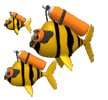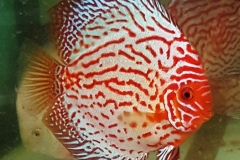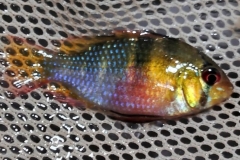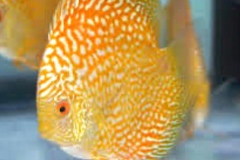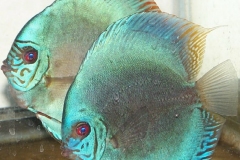Previously we went over how to artificially raise the fry. Now we will go over raising the fry naturally. Next we will go over growing out the baby Angelfish.
Naturally raising the fry requires very little work on your part. The parents do all of the work for you. Unfortunately, it is very common for the parents to eat the babies, so most breeders artificially raise the fry. There are advantages to naturally raising the fry over and above that it is much easier. Angelfish fry will eat some slime off the parent’s side for the first few days. Unlike Discus, they can survive without the slime and will immediately start eating other food. This slime is very high in protein and contains antibodies that help the babies fight off disease. Naturally raised fry will grow much faster at first and will have more resistance to disease throughout their lives.
There is also the enjoyment of watching your Angelfish raise the fry. They will stay mostly around the parents for the first month and the parents will zealously guard them. When a baby strays to far, the parents will mouth it back to the main school. This is done by both the males and females. There is nothing more rewarding than watching your large Angelfish parents and the fry swimming around the tank as a loose school. I find this fascinating and it has always been my favorite part or the hobby.
Things you should remember. These babies will be very small and weak, so you will need to turn off all filtration, except for a sponge filter. You can also take the sponge from a sponge filter and put it around the intake tube of an over the side filter. Canister filters are two powerful to put the sponge on their intake tube. The biggest mistake that you can make is to do a water change in this aquarium with water that is not EXACTLY the same temperature. Angelfish fry are extremely sensitive to temperature shock and will die if you do a water change with water that is more than a few degrees different in temperature. With that said, Angelfish fry are also very sensitive to ammonia burn, so you will need to do daily partial water changes.
Start adding a small amount of live baby brine shrimp to the tank within 24 hours of them becoming free swimming. Drip it directly over where the fry are located. Be careful how much you add as if most is uneaten, it can foul the water and lead to ammonia burn. After two weeks, slowly reduce the amount of baby brine shrimp you add and slowly start adding crumbled beef heart flake. After a month, they should be eating exclusively beef heart flake. By the end of one month, they will be about ½ inch. At this point they are much hardier and you are pretty much out of the woods. They will reach the size of a dime in about three months.
